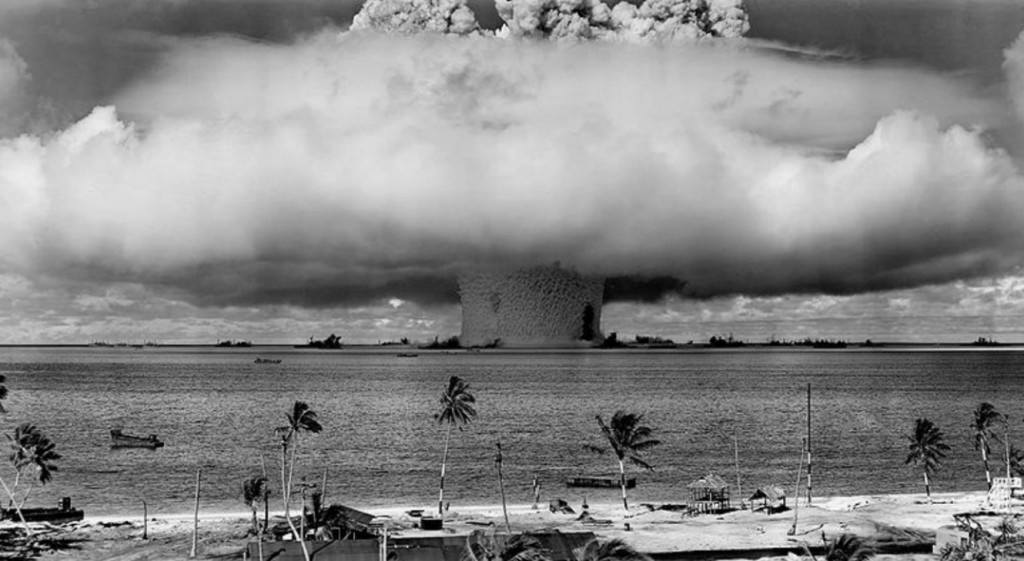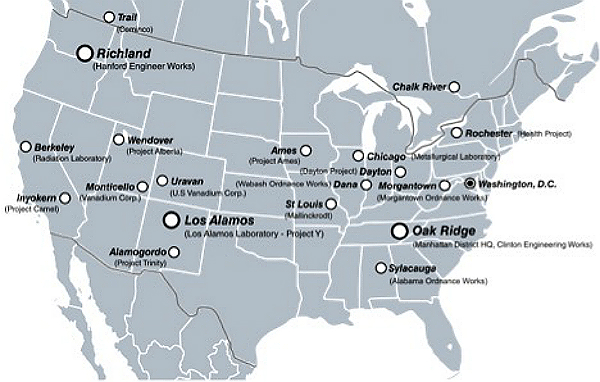Join War on the Rocks and gain access to content trusted by policymakers, military leaders, and strategic thinkers worldwide.


World War II marked the second time in the industrial era when the world’s great powers threw the entirety of their military and economic might against one another. Like the First World War, belligerents committed the best and brightest of their industrial, organizational, and scientific might to winning the war. However, the scientific innovations that took place between the wars produced weapons that were inconceivable in 1914. By the end of the Second World War, the dawn of the nuclear age was at hand. There were a number of circumstances that had to align for the United States to become a nuclear power in 1945. The men, the science, and the drinks, all had to be just right.
Einstein realized in 1903 that matter and energy were equivalent, and that even tiny amounts of matter contained unbelievable potential. For years however, his findings were regarded as a unique theory among a number of competing models of the relationship between matter and energy. It wasn’t until 1932, when two scientists, Cockcroft and Walton, demonstrated that by firing protons at metals the nuclei would split apart and release tremendous energy. Of course, the energy required to generate a beam of protons in 1932 was incredibly high, and the experiment consumed far more energy than it released.
As time went on, understanding of atomic nuclei accelerated, as it was found that neutrons were more effective than protons at colliding with the nucleus. Austrian scientists Hahn and Strassmann discovered that the neutron actually cleaved atoms in half, and the Italian Enrico Fermi was beginning to examine heavy elements such as Uranium. By 1938, many of the scientists began to flee Europe for America, as a rising tide of anti-Semitism made academic careers difficult for many. Niels Bohr and Leon Rosenfeld famously unraveled the explanation for nuclear fission on the boat from Europe to America. Within a year, many of the greatest physicists in the world — Bohr, Fermi, and Leo Szilard, among others — had fled fascism’s advance and were working tirelessly in the United States on understanding and proving the existence of nuclear fission.
The actual science of nuclear fission was only part of the technology needed to create an atomic bomb. First, the science of synthetic materials had only recently reached a point where artificial materials could handle the radiation and stress of nuclear detonation. Stainless steel, synthetic rubber, and artificial lubricants were all developed during the First World War. The other critical element that made the Manhattan project possible was improvements in industrial organization. Thanks to commercial air travel, telephones, and airmail, research and manufacture could take place along several lines at once and in locations as distant as Oak Ridge, Los Alamos, Argonne, and Handford (see below). The United States needed someone who could supervise and understand the entirety of the project’s scope, which ranged from enrichment of uranium to metallurgy, and for that matter, explosives research.

Manhattan Project Sites Throughout the United States
For this monumental task, the U.S. Army found two men. The first was a military officer renowned for his deft navigation of the Army bureaucracy, Lt. Gen. Leslie Groves. The second was a civilian scientist and the project’s technical expert. His name was J. Robert Oppenheimer. Oppenheimer grew up the son of German immigrants who had achieved wealth in the textile industry. As a child, he loved exploring Central Park, and developed an interest in the geology of the region that bordered on obsession. Robert Oppenheimer studied and published extensively in Europe as a young man. He gained a reputation as a diligent and innovative researcher, but also as a volatile and emotional man. In one incident, a depressed Oppenheimer learned of a friend’s impending marriage and reacted with a jealous rage. Oppenheimer attacked his friend and ineffectually attempted to choke him. However, Oppenheimer was thin-framed, and his lack of physical strength meant that his friend easily shucked him off.
In 1941, as the United States government began the search for the atom bomb, 37-year-old Oppenheimer was teaching in California. Then-Col. Groves recruited the middle-aged academic to run some calculations for neutron chain reactions, but soon recognized that Oppenheimer was not just a brilliant physicist, but a man with the broad range of knowledge demanded of the Manhattan Project’s leader. More than that, Groves sensed in Oppenheimer an obsessive passion that he felt would push forward the project at an unrelenting pace. The eccentric but driven Oppenheimer was chosen over many scientists, Nobel Prize winners among them. Groves reasoned that their reputations were secure, whereas Oppenheimer’s professional reputation hinged entirely on the project’s success.
Grove’s assessment of Oppenheimer was accurate. As the project got underway, and a facility was built from the ground up in the isolated area of Los Alamos, Oppenheimer developed a singular focus on the project. He was personally involved with nearly every experiment, seminar, and meeting. His presence added a level of focus and intensity to everyone involved. This focus was amplified by the fact that there were no distractions outside the remote desert lab. Discussions and debates would often continue late into the night, moving to Oppenheimer’s quarters where he would make legendarily strong martinis.
As the months turned to years, Oppenheimer began to unravel. His weight dropped, his marriage became punctuated with ever more frequent fights. Several colleagues reported that he seemed to survive on coffee, martinis, and cigarettes alone. By the time the Trinity test device detonated in 1945, the nearly six-foot-tall Oppenheimer weighed less than 120 pounds.
The martini in the 1940s was a cultural fixture. Its origins are still debated even today. One story tells of a gold miner in California who struck it rich and went to the local tavern to celebrate. The bartender only had a handful of ingredients on hand, and concocted a drink he dubbed a “Martinez” after the name of the town. Others claim the drink appeared earlier, when an Italian manufacturer began to market its vermouth under the Martini & Rossi brand in the 1860s. Still another story is that the drink is named after the Martini-Henry rifle used by the British Army, since both were reported to have a strong kick.
Regardless of origin, the martini didn’t grow in popularity until Prohibition. The iconic “bathtub gin” was easily made in the home, so gin-based drinks were readily available in speakeasies. The martini boomed in popularity right around the time many famous drinkers of the 1940s came into adulthood. Oppenheimer, Churchill, FDR, Alfred Hitchcock, and Humphry Bogart all drank martinis throughout their lives.
The martini evolved over time. At its inception, it was two parts dry gin to one part vermouth and served without garnish. As the roaring twenties came, the ratio of gin grew to three to one, and the iconic olive garnish was added (although many purists still believe the twist to be the only acceptable garnish). By the 1940s, the drink grew stronger still. Alfred Hitchcock famously preferred his martinis five to one, but his martinis were made with instruction to give a glance at the vermouth from “across the room.” Owing to the difficulty of getting supplies to the remote Los Alamos lab, Oppenheimer crafted his own martini recipe that used only a dash of vermouth, as well as lime and honey.
On July 16, 1945, in Alamogordo, New Mexico, Oppenheimer’s work came to fruition. The Trinity device brought on the nuclear age. Within weeks, atomic bombs were dropped on Hiroshima and Nagasaki. Imperial Japan soon surrendered. The Manhattan Project was made public and Oppenheimer catapulted into the national spotlight. The bomb created a generation of scientist-heroes that were adored by the public. After the war, Oppenheimer left teaching, instead leading a cross-disciplinary team that tackled the most pressing problems of the day. It was an early version of the modern think-tank now called the Institute for Advanced Study. In 1947, Oppenheimer was approached to chair an entity known as the Atomic Energy Commission. The AEC was to be a civilian agency that controlled and regulated the use of nuclear fission for civilian and military purposes. Oppenheimer’s work in the early years helped create a framework that allowed for many of the peaceful nuclear technologies used in energy and medicine today.
Oppenheimer’s sterling public image was not to last long. In 1949, his political enemies alleged that he was in fact a Communist. This was at the height of McCarthyism, and Oppenheimer was a juicy target for Sen. Joseph McCarthy. The legendary scientist was forced to testify before the House Un-American Activities Committee (HUAC). While he offered no direct link between himself and the Communist Party, many of his graduate students were members, as was his brother Frank and his sister-in-law. Oppenheimer also donated to a number of causes related to Communism in the 1930s, especially opposition to Franco in the Spanish Civil War. The controversy lingered over Oppenheimer’s head for years, and in 1953, his security clearance was revoked, one day before it otherwise would have lapsed. It was an ignoble conclusion to the tale of a man who was until then considered a model of American ingenuity.
The Manhattan project was a watershed event in the United States’ military history — not just because it developed the atom bomb, but also because it created a model of the public–private efforts that gave birth to the massive military industrial complex of today. Stealth fighters, ARPANET, and MRAPs can all trace their developmental heritage back to the Manhattan Project, J. Robert Oppenheimer, and a strong martini recipe born in the deserts of New Mexico.
The Oppenheimer Martini is Dr. Oppenheimer’s recipe for the cocktail, making due with the limited supplies available at Los Alamos. You may not be splitting the atom, but that doesn’t mean you can’t drink like Oppenheimer!
4oz Gin
Smidgen of Dry Vermouth
Lime Juice
Honey
Stir the gin and vermouth with ice until chilled. Then strain into a chilled martini glass whose rim has been dipped in equal parts lime and honey.
As Oppenheimer himself often said, “To the confusion of our enemies!”
Paul Lewandowski is a graduate student, veteran and writer. He prefers a good gin gimlet to just about anything else. America is his favorite country and his favorite color is a tie among red, white, and blue.
